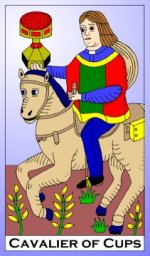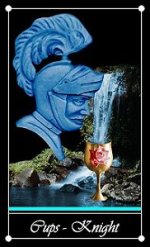Knight of Cups (Rider Waite Tarot)
First Impressions
Knight in shining armour. Grail Knight. Prince Charming. Lancelot. Riding in on a white steed. All of these come to mind when examining the Knight of Cups in the Rider Waite Tarot. He’s the gleamingest, most romantic figure in the deck. Graceful, gentle and chivalrous, he is a courtly figure of bygone days. His armour is pristine and bright, his expression is peaceful, even his horse is as pretty and perfect and bright-eyed as a carousel pony. I always think that there’s something too good to be true, something carefully contrived, about this character. He’s like something out of a fairy tale.
He (the Knight, I mean) holds the reins in one hand while the other holds the goblet out. It’s as if he’s offering it to his one true love. We can’t see what is in it, if anything. The reins have a pattern like rippling water, and the Knight holds both cup and reins with bare hands. His armour is silvery and shining, plate armour – no dinky dull chain mail, that’s far too plebeian. His helmet is the same shining silver, with the heavy visor pushed up to reveal his thoughtful and smiling expression. Both stirruped feet and helmet are adorned with shiny wings elongated like the Nike of Samothrace. I wonder if the resemblance is deliberate, a bit of a point toward the Knightly aspect of battle, action and achieving victory. Or perhaps to indicate the element of Air of the Knights (or are Kings Air and Knights Fire? Oh dear, I always mix those two up). There’s no mystery about the tunic over his armour, however; adorned with red fish, it points straight at the Watery element of the Cups, and red for the passion of the hot-blooded lover.
The horse’s head is down as if pulling slightly at the reins. Maybe he chafes a bit at the sudden inaction, at being so suddenly halted in mid-stride. He tugs at the reins, and one front hoof and one back are raised as if pawing impatiently at the ground. Water is passive, inactive. But the horse might represent some element of the animalistic, instinctive nature of humans. The base instincts and the impulse that drives Knights to action.
Horse and rider stand on yellow sand beside a lazily twisting river. Trees and rugged cliffs stand on the other side of the river from the Knight, as though it not only represents the Water element, but also a barrier or obstacle. And the sand, emblem of heat and dryness, is an interesting contrast.
The posture of horse and armoured, plumed rider parallels, as has been mentioned so often, that of Death in this same deck. But I’ll look at that in a bit. Isn’t the Knight of Cups’ zodiac association Scorpio? I can’t remember off the top of my head.
The Knight of Cups is usually the most “romantic” card of the deck to me. It is the lover, the great romance, the fairy tale, the being swept off one’s feet. At least that’s how I always see it.
Creator’s Notes
Waite says that this card means:
Waite said:
Graceful, but not warlike; riding quietly, wearing a winged helmet, referring to those higher graces of the imagination which sometimes characterize this card. He too is a dreamer, but the images of the side of sense haunt him in his vision.
Very true, the bit about being graceful rather than warlike. A dancer rather than a warrior. I always thought of imagination, of dreams, being the area of the Page of this suit rather than the Knight, but Waite is emphatic about it. The last bit, the “images of the side of sense” makes me think of the dreamy yet troubled Knights of the Round Table on their various quests and adventures. And Waite did so love him a good Grail myth …
Others’ Interpretations
In the
Pictorial Key to the Tarot, Waite interprets this card to mean:
Waite said:
Divinatory Meanings: Arrival, approach--sometimes that of a messenger; advances, proposition, demeanour, invitation, incitement. Reversed: Trickery, artifice, subtlety, swindling, duplicity, fraud.
Tarotpedia gives the following keywords:
tarotpedia said:
A visionary
Acting upon intuition or a gut feeling
Idealism
Being romantic, sensitive, or temperamental
I’m not ordinarily a fan of just keywords for interpretation, but these seemed to be on the money.
Symbols and Attributes
Astrologically the Knight of Cups is associated with Scorpio. So is Death in the Major Arcana, which I think Waite and Colman Smith were hinting at when the two figures came out so similarly. It is a very intense sign, and secretive, with a lot going on beneath the surface; this is the case with the Knight of Cups as well. There’s even the river there like in Death. And it is a sign associated with sexuality, as well. But wait, there’s more. If we go by the decanate system made famous in these parts by Scion (but as I lost his file, I’m going by that on Paul Hughes-Barlow’s supertarot.co.uk website), the Knight of Cups is two-thirds Scorpio and one-third Aquarius. The sigil or glyph or whatever you call it of Aquarius is wavy lines like water that is calm but not still. We see it in the Six of Cups as well, but here we see that in the horse’s reins. Sharing the optimism of the Star, which is also associated with Aquarius, I see this as reflected in the idealization of this Knight.
Elementally he is the Air (Knight) of Water (Cups). Water vapour, then? The transformation from a water to a gas, like the transformation that is Death, the transformation from the old year to the next or the old world to the next of Scorpio and Samhain. Or might it represent fog, or mist? Like fog, this Knight is a bit secretive and doesn’t show everything clearly. Not one to wear his heart on his sleeve, I think.
… maybe I’m just a bit out to lunch on this part of it …
Knights are typically abstracted as searching, as seeking, as questing. When combined with the emotional nature of the suit of Cups, I interpret the Knight of Cups as meaning searching for love, or an abstract ideal. He is on a spiritual quest. He is commonly considered the Grail Knight of the Tarot. Opinions seem to vary on exactly
which Grail Knight he is - Lancelot, Galahad, Parsifal, likely others (I’m not really very conversant on Arthurian legend at all) - but I see him as Galahad. Usually depicted in legend as the pure of heart and intention, as the chaste and ideal, as the “perfect knight” and the very picture of medieval chivalry, he is the one I picture here as the Knight of Cups.
The knight sits in profile, riding to the right. Or arrested in the process of riding to the right, he is still facing ahead. Forward looking, as a knight should be.
While he wears armour, his hands are bare. No gauntlets, no gloves. For all that he self-protective, not revealing all, he is still open and receptive to sensation and new experience. He is willing to risk being hurt in the process, if it means a chance to grasp happiness, experience, sensation. With one of those bare hands he holds the cup. He is open to romance, to love, to relationships. He even holds it out as if offering a drink to the one he loves. With the other hand he holds the reins of the horse. He is in control of, yet receptive to, his instinctive and animal nature. His armour itself is pale, almost white. I see it as a bit of a pun: the fair-haired boy, the knight in shining armour, the man wearing the white hat. He’s the good guy. The plumes on helmet and heels make us think of those on the god Mercury, or Hermes. The god of communication, Mercury is an interesting side note to this Knight’s character. And Hermes is associated with times of transition, of transformation. The theme of Scorpio again. The fish on the garment over his armour is a link to the element of Water, and also to Jesus as I found when looking at the fish in the Page of Cups’ cup. Again, it all ties back to the whole Grail thing. The fish are red, as red is the colour of passion. The Knight of Cups is a lover, and a passionate one.
The horse is white like the horse that Death rides, but also a sign of peace. Notice how he seems to be stopped. It’s as if the Knight, dwelling in a dreamy landscape of his own, is so unaware of what is happening around him that he has slowed the horse to a stop. His imagination, his dreaminess, is turned inward so much so that the outer world does not matter or even exist. As he grows in maturity he will no doubt learn to express his creativity and imagination outward, to accomplish much and do much good. But for now he is in a little world of his own.
This is, I think, also expressed somewhat in the river that runs before the Knight. Because the Knight of Cups is more inwardly focused, lost in his dreams, the creative force is lessened. This is reflected in the fact that the life-giving water is seen as an ocean in the King, the shore of a sea or lake in the Queen and rolling waves in the Page, and just a narrow river in the Knight. The river is narrow, choked off, and the land around it is arid and parched. I don't mean that he's emotionally stunted or anything, just that he turns it inward and not out. Note too that the river cuts him off from the rugged mountains of his journey. His dream world is divorced from the real one. He has to bridge the gap between the two.
My Interpretation
The Knight of Cups is the quintessential romantic dreamer. One that is so engaged in his dream world that it is as if the real world is irrelevant. It fades away to insignificance. And this isn't necessarily a good thing! Rather it makes him a little dreamy and unreliable when it comes to real-world matters. But on the plus side he is an incurable romantic, eternal optimist and passionate yet considerate lover.
He might be an idealized dream lover. One that isn't real, one that exists only in the imagination. Or even more abstract, a quest for ideals or his own unattainable dream.



